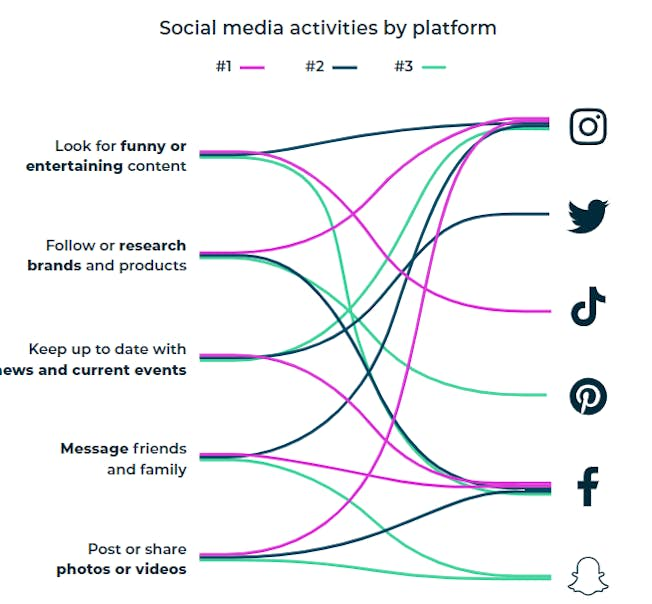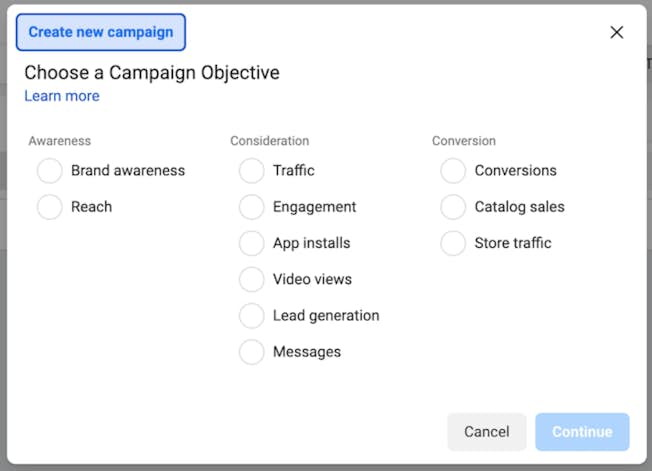Your cart is currently empty!

Facebook is one of the oldest surviving social media platforms and has grown to become an integral part of the Meta machine. With nearly 3 billion users, Facebook is the most-used social network and the place Americans spend the most time every day, according to Statista.
While there’s no question that Facebook is currently the king of the hill, no king rules forever. The rising popularity of TikTok and the publicity around security breaches and a lack of content moderation on Facebook all create challenges for the network’s future.
That doesn’t mean marketers should abandon the platform because the user numbers and reach are too huge to ignore. But it’s important to know the strengths of Facebook and how to use it effectively to advertise to your target audience.
In this blog, we’ll give you a crash course on how to use Facebook for advertising.
Why Use Facebook?
While we’ve outlined the user numbers and popularity of Facebook, let’s look at the benefits of using the platform above others.
As a marketer, you already know that people visit and engage with social networks for different reasons. For example, Instagram users are looking for entertaining content or updates from influencers. In contrast, a lot of Facebook users go to the platform to keep up with family and friends or to share posts and videos. Of course, there’s always overlap as people use multiple social platforms every day, but it’s important to understand the intent of users for each.

There’s also the targeting power of Facebook to consider. The network allows marketers to engage with users at any stage of their journey by choosing awareness, consideration, or conversion goals for full funnel targeting. B2B marketers can also create lookalike audiences based on an existing email list, customer base, or website visitors.
There are also a wide variety of ad formats from carousels to videos to Stories to sponsored posts. As you can target so effectively, it’s also cost-efficient – meaning that your ads only get in front of the people you want to see them.
It’s also worth noting that Facebook is great for measuring ad performance. Depending on the format, you can measure actions that users can take before leaving the network (e.g. reach, ad engagements) to off-Facebook events (e.g. revenue, conversions).
So how can use Facebook successfully as a beginner?
7 Ways to Leverage Facebook
Facebook is a versatile platform with lots of ad options so it’s important to have a robust plan before spending any money! Here’s a step-by-step guide to how to get everything lined up so you can create ads that will perform well on the platform.
1) Formulate a Plan
Just like a business plan is your roadmap to reaching your business goals and milestones, you’ll need a plan to help achieve your social marketing goals as part of your wider digital marketing strategy.
You don’t want to just jump into Facebook advertising with the vague purpose of “growing my business.” You want to figure out what your business goals are, where you want to see the improvement, and what methods will give you this improvement. In other words, you need a solid ‘plan of attack’ to come out with a win.
So you need to start with the basics to formulate a plan:
- What product or service are you looking to promote?
- What demographic are you targeting?
- What channel is your target audience active on?
- How are people searching for your product or service?
- What is your USP?
These simple questions will help clarify what you are trying to achieve and the best way to do that. For example, if you’re a fitness brand, then Facebook’s demographic will fit perfectly because the largest audience are men between the ages of 25 and 34 years (at nearly 18%).
2) Tell Facebook What You Want
Facebook is user-friendly when it comes to advertising. However, you’re only going to get the most from it if you know what you want to achieve.
For example, you may want to promote a video that drives people to a custom landing page. Facebook has parameters that can handle this goal. Or you may want to generate more leads by promoting a free downloadable. Facebook has specific measures in place for this too.
The trick is to choose the right objective for your campaign. There are three to choose from depending on the stage of a customer’s journey: awareness, consideration, and conversion.

To save money and time, make sure that you know exactly what you want to achieve and choose the right criteria so Facebook knows what you want. There’s nothing worse than wasting budget by not thinking things through.
3) Narrow Down Your Audience
We mentioned that Facebook has great targeting options so let’s look at them in more detail.
For transparency, Facebook makes it easy to see who you want to target, as you can choose between:
- Fans or followers
- Friends of Fans
- Behaviors or Interests (this can be very targeted down to whether someone likes yoga or an important life event!)
- Remarketing
Like most social networks Facebook offers demographic targeting based on criteria such as age, location, and gender. Then there are more detailed targeting options based on education or income, which allow for personalization. For example, you can narrow the audience down to people who have graduated from college, earn a medium income, are parents, and love music. (Check out this infographic from Wordstream for all the options.)

Note: You can target behaviors and interests along with demographics in ads so don’t limit yourself. You can also try interest stacking if you need to widen your audience.
You can also do customer audience targeting. This allows you to retarget users who have engaged with your brand either through your own data such as a website or app, or Facebook’s data which is interacting with your brand on the network.
A great feature on Facebook is its lookalike audiences. This allows you to choose an existing audience which Facebook will analyze and categorize to find users who show similar behaviors to those on that list.
When it comes to competitors, you can target users who have shown an interest in certain brands. You can then create a custom audience of users that have shown an interest in ten competing brands.
4) Choose Your Ad Placement
Now that you know what you’re trying to do, and who you’re trying to reach, it’s time to decide where you’re going to run your ads.
Simple marketing minds might go for a ‘scorched earth tactic’ of simply hitting everything, everywhere. But we believe that precision will get you better results.
Across Meta (which includes Facebook, Instagram and Messenger), there are lots of ad options.
- Facebook feed – ads will appear in people’s feeds (desktop and mobile)
- Facebook marketplace – ads will appear on the Marketplace homepage or on browsing
- Facebook video feeds – ads will appear between organic videos in video-only placements
- Facebook right column – ads will appear in the right column of the platform
- Facebook Business Explore – ads appear in Facebook Business Explore when tapping on a post header or comments in mobile
- Messenger inbox – ads appear in the homepage of Messenger
- Facebook Stories – ads appear in people’s Facebook Stories
- Facebook Reels – ads appear in the Reels tab
- Facebook in-stream videos – ads appear in video on demand and in a select group of approved partner live streams
- Facebook search results – ads appear next to relevant Facebook and Marketplace search result
Where you place your ad will depend on the type of content, budget, and audience.
For example, if you’re targeting browsing mobile users, then it’s not a good idea to put your ads on desktop browsers. Think critically about when your target is browsing, what devices they use to scroll through social, and the kind of content they most frequently consume. Then use this data to plan the best time and place to position your ad or sponsored content.
5) Define Your Budget
You’d think that this would be the very first factor you’d consider, but in reality, you probably only want to arrive at this figure once you’ve sorted through all the other variables.
Facebook will give you an option for how much you’re willing to spend on your advertising, and there are a lot of parameters to do this. So think about how you want to spend your Facebook ad budget. Are you looking at budgeting for the lifecycle of a campaign? Is this an A/B test to get insights? Or do you want to cap a daily spend? Perhaps you may want to set certain conditions for when ads run, and then pay upon the deployment of those ads.
If you’re running on a tight budget or want to test the waters, you can set up ad scheduling. This feature allows you to tell Facebook to only run your ads when it is relevant to your business or product/service. This could be during your opening hours or audience (e.g. showing your homemade tacos at lunchtime).
Luckily, Facebook allows you to tweak precisely how much you want to spend. After you get this figure, you can compare it to your ad expectations. And remember, this isn’t something that you have to commit to forever.
Budgeting is flexible, so you can adjust and redirect as you see fit, depending on the kind of metrics you get back.
6) Create & Format Your Advertising
Here’s where the all-important creative and human touch comes in. Now that you’ve more or less figured out your budget and ad placements, it’s time to make sure you’ve got the content to deliver.
Facebook offers a variety of formats, including single image ads, carousel ads, video ads, and even ‘collections’ for a comprehensive mobile experience. The format that you choose is going to depend largely on what your goals are.
There’s no denying the popularity of videos on Facebook but don’t discount the cost-effectiveness and reach of a single, impactful image when paired with some good copy. Here’s a great example from Slack’s ‘Make Work Better’ campaign.

Don’t forget the little details at this point either. Remember to include a Call-To-Action button so that you can get responses that you can measure. Include the URLs that may lead curious customers to more in-depth information about your product or service.
It’s these last little pieces of the puzzle that can make the difference between a customer clicking on your ad and converting to a sale or someone passing by because you didn’t give them the opportunity to learn more.
7) Use Your Metrics
Finally, when everything is set up and your ads are live, dig deep into the data. The real beauty of digital marketing is that you get a goldmine of metrics that can be hugely useful to current and future campaigns.
Through Facebook, you should know exactly how many people got your ad, how many people clicked on it, and how many went to your website. You’ll also know whether you got visitors to your site from Facebook or Instagram.
With these metrics, you can see what’s working and what’s not. If certain ad methods aren’t performing well, change or trim them out. If others are working better than you expected, allocate more budget and resources to them.
Thanks to the vast collection of user data that you’re getting, you have far better information to make strategic decisions than someone who can only guess how many people saw a poster in a subway and whether it engaged them or not.

